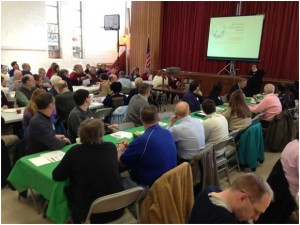Navigating cultural change

Feeling disoriented by changes in church and culture? You’re not alone, as Bishop Burkat told a recent gathering of congregation council leaders. A “Great Emergence” is both opening new opportunities for Christianity and challenging the institutions formed in the last 500 years, she said. It’s part of a pattern of moving from orientation through disorientation to reorientation that the church has experienced every half-millennium. The shifts are real, and present opportunities for congregations and not reason to panic, said Bob Fisher, assistant to the bishop.

Council Leaders met with the Bishop at St. Paul’s, Glenside. The Mission Investment Fund of the ELCA helped sponsor the event.
More than 80 congregational council officers gathered with Bishop Burkat on Saturday, March 9, to discuss the opportunities presented by the decline in religious participation in our society.
Bishop Burkat shared her perspective on the “great emergence” that is springing up new faith expressions and challenging denominations and other religious institutions to change how they do business. The Bishop also said that the Synod itself has responded to these changes, operating with fewer staff but with a “constellation” of teams and networks that arise and shift based on ministry needs. The Synod staff works with more than two dozen teams, from candidacy to Tanzania, social media to disaster response, youth to retired pastors, she said.
It’s not surprising that a period of disorientation is facing the church today, she said. The church and society hold “rummage sales” periodically: the Reformation and the enlightenment 500 years ago; the Great Schism between Western and Eastern Christianity about 1,000 years ago; the fall of the Roman Empire 1,500 years ago, and the rise of Christianity nearly 2,000 years ago. Biblical scholar Walter Bruggeman has observed this pattern of orientation, disorientation and reorientation throughout the history of God’s people, the bishop said. This pattern, which can also be viewed as living, dying and rising, is also seen in the Resurrection.
Though nearly 1 in 5 Americans – and 1 in 3 people under age 30 – report having no religious affiliation, it’s not time to panic, Bob Fisher, assistant to the bishop for mission interpretation, told the group. Though young people are not looking for “grandma’s Sunday service,” congregations are experimenting with “God on Tap” events and dinner conversations to engage young adults. The Church has many treasures in its attic – including small, house groups, spiritual practices such as lectio divina and contemplative prayer, and more – that can be dusted off and repurposed to speak to the emerging culture. Some of the opportunities are:
- Responding to the rise of six distinct generational cohorts now living at the same time. Intergenerational spaces are needed more than ever, yet the church can also learn to speak directly to each of the cohorts, respecting their unique perspectives and experience.
- In a culture that values narrative over data, the church is a community of story. Translating the story of God’s love into language the culture understands can connect with people distanced from or turned off by religion.
- Along with this, congregations have to know and tell their own unique story, rather than adopting a “one-size-fits-all” approach.
For more information, contact Bob Fisher at rfisher@sepa.org or 267.323.3743.



